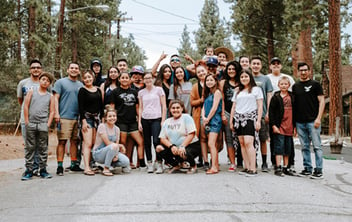Get the free Volunteer Lifecycle Planning Guide
Volunteers are an integral part of the nonprofit world. In fact, over 40% of charities rely heavily or entirely on their volunteers to maintain operations. This fact has grown since the pandemic. According to LinkedIn, the number of volunteer opportunities listed per month has doubled since 2017.
As a volunteer manager, you want happy volunteers! Why? Because happy volunteers show up time and again to serve their communities!
It’s important that you make sure every volunteer feels empowered by their choice to give their valuable time to your cause. Thus, forward-thinking volunteer managers need to make an effort to cultivate a happy volunteer workforce.
We’re sharing these 4 keys for bolstering happiness and fostering better relationships with your volunteers, so you can adjust your volunteer engagement strategy in a meaningful way:
Article Contents
Comfort
When people know that you’re considering their comfort, they tend to be happier to participate in your volunteer activities. Even if the task feels uncomfortable, developing a sense of trust and teamwork can help inspire volunteers.
Check-in with volunteers regularly about these specific areas:
- Volunteer Activities
- Volunteer Training
- Physical Comfort
Volunteer Activities
The volunteer activity is what you’re asking your volunteers to actually do! Assess your volunteers’ comfort with your activities by asking yourself (and your team) these questions:
- What safety measures are put in place?
- Do volunteers understand what is expected of them?
- Is the task accurately described?
You can also use background checks to help ensure all staff, community members, and volunteers are qualified to participate in your activities.
Volunteer Training
You can promote volunteer happiness and comfort by offering appropriate volunteer training. In fact, organizations that prioritize volunteer training are more likely to see greater volunteer retention and engagement (prepared volunteers make for happy volunteers!).
Make sure to complete volunteer training for each volunteer. Prior to training, let volunteers know what to expect. Is the training online? What language will your organization use to convey key information?
As you think through training, keep the following questions in mind:
- Do volunteers understand the training?
- Do you have written training procedures and handbooks to make volunteers feel comfortable with rules and guidelines?
- Are there any specialized training requirements?
- Who is paying for specialized training?
Physical Comfort
Don’t overlook the physical comfort of your volunteers while they’re on the job. You’ll want to consider questions like these, and communicate the conditions of the activity with your volunteers before they arrive:
- What are the physical requirements and conditions? For instance, how long will volunteers be expected to sit or stand? Will they need to be able to lift items to participate?
- What fears might some volunteers have?
- Are you providing food and water? Let volunteers know if and when you’re providing food and water, or if they need to bring themselves.
- What kind of footwear or clothing is required? Should volunteers wear close-toed shoes or clothing that can get messy?
- What are your volunteer’s dietary restrictions? Make sure to understand and accommodate allergies if possible. Also honor your volunteers’ other needs (such as fasting holidays, Halal or Kosher food).
Convenience
Like you, volunteers lead busy lives; avoid asking too much from your volunteers. Before assigning a volunteer role, estimate and communicate the time commitment. Are you asking for 10 hours per week of their time? 3 hours per month? Provide a variety of options so that you’re casting the widest net possible when recruiting volunteers for your program.
Here are some important considerations for volunteer happiness and satisfaction when it comes to making your program accessible and convenient:
Time Commitment
- How are you using volunteers’ time?
- Do you have enough variety in opportunities that anyone can participate?.
- Can people assign or self-schedule shifts?
Technology
Technology can be used to make the volunteer experience more convenient for volunteers. Some volunteer management systems, for example, will automatically log hours when volunteers arrive on site. This removes the burden on the volunteer to log their own hours, and can instead allow them to focus on their service. Keep these questions in mind as you think of ways to incorporate technology to make the volunteer experience more convenient:
- Are volunteers familiar with using technology?
- Can you implement a volunteer management system that will make the volunteer experience smoother?
- Are you able to provide assistance to those who may not have access to technology?
Transportation
Transportation is a barrier to access for many folks.
As you plan your volunteer opportunities, keep the following considerations top of mind:
- How are your volunteers getting to and from locations?
- Is public transit available in your area?
- Is transportation an economic challenge for those who are trying to volunteer?
- Are you able to provide transportation or a carpooling system for volunteers?
- Do you offer opportunities that can be done from home?
Want this Volunteer Lifecycle Planning Guide delivered to your inbox?
Communication
A lack of consistent, transparent communication is one of the first reasons that volunteers become dissatisfied. Do not overlook your volunteers. A forgotten volunteer is a lost volunteer–and perhaps a lost donor as well.
Rather, create a regular volunteer outreach program. Every interaction with your volunteers is a chance to build trust through communication and honesty.
Are you looking for the best ways to stay in touch with your volunteers? Try these suggestions:
- Volunteer Newsletter: This one is top of the list for a reason! A consistently monthly or twice-monthly volunteer newsletter that can be relied upon allows volunteers to consistently feel in the know and plugged into your program!
- Social Media: Many of your volunteers are likely spending lots of time on social media. Reach them where they are with smart social media campaigns for your volunteer program. This is a great chance to repeat messaging with consistency beyond just your regular newsletter.
- Volunteer Website or Portal: Making certain this information is centralized and accurate means volunteers will feel it’s reliable. Your volunteers know with certainty that they’ll find updated information on your volunteer program site about upcoming opportunities or policies.
- Meet and Greet: Show up in person and meet your volunteers! That way, you can introduce yourself, communicate gratitude, expectations for the day, etc.
And, if you’re already using these communication channels, focus on continuing to create highly relevant and engaging content with consistency for happier volunteers!
Appreciation
Volunteer recognition and appreciation is an important component of cultivating happy volunteers. Even your most consistent and dedicated supporters want to be acknowledged for their achievements and the impact they’re making in the community.
Here are some tried and true volunteer appreciation strategies to recognize your volunteers in a meaningful way:
- Track Volunteer Hours: Implement a system that can track your volunteers’ hours and participation. By keeping track of these data points from the beginning, you can award them specifically and appropriately based on their dedication. Some organizations use gamification to make logging hours fun. So up the fun factor on hours logging and watch volunteer happiness increase!
- Name a “Volunteer of the Month”: Recognize your top volunteers each month by including an announcement in your volunteer newsletter, on your volunteer site, or on your social media.
- Host a Volunteer Appreciation Event: A celebration is a great way to show your volunteers that you appreciate their hard work and can go a long way to improving volunteer happiness. Host a surprise lunch, a banquet, or try these other volunteer appreciation ideas.
FREE DOWNLOAD
Don't forget your free Volunteer Lifecycle Planning Guide!
Leveraging the power of volunteer management software ensures you have the information you need to make your volunteers feel seen and heard. There are many platforms that can help you communicate your appreciation, and award certificates or badges based on volunteer milestones and achievements. Check out our list of the top 25 tools for nonprofits and keep your eyes open for tools that support volunteer engagement!
No matter how large or small your nonprofit, you have the opportunity to foster happiness and satisfaction among your volunteers. By keeping some of these strategies for success in mind, you’ll drive deeper volunteer retention, keeping volunteers engaged and happy for years to come.





